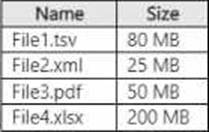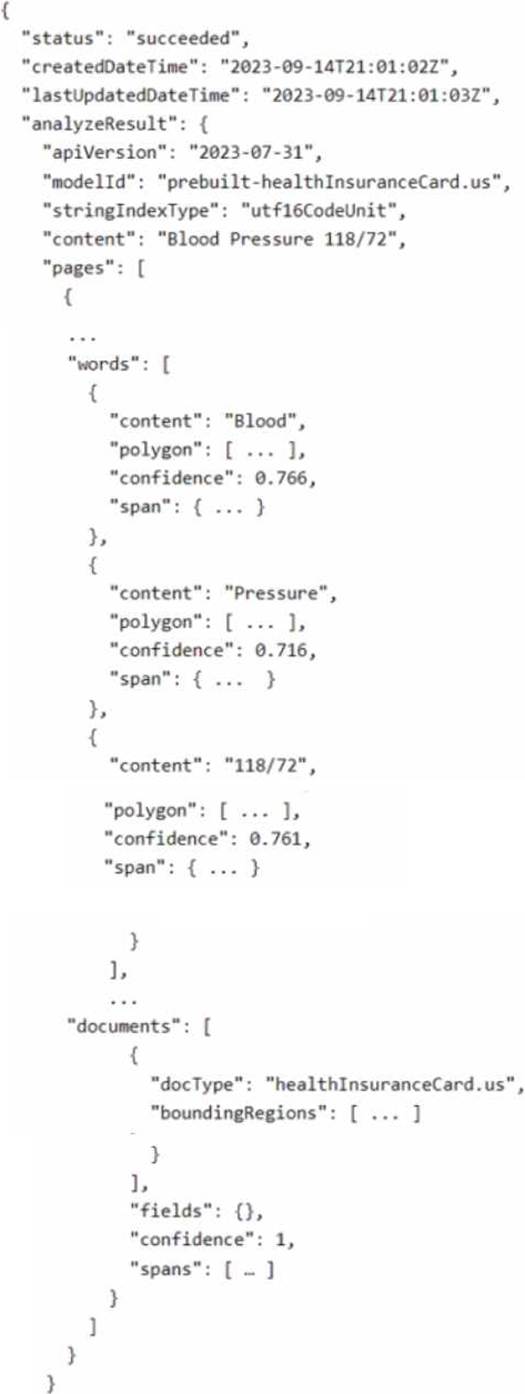Practice Free AI-102 Exam Online Questions
You are building a chatbot for a travel agent. The chatbot will use the Azure OpenAI GPT 3.5 model and will be used to make travel reservations.
You need to maximize the accuracy of the responses from the chatbot.
What should you do?
- A . Configure the model to include data from the travel agent’s database.
- B . Set the Top P parameter for the model to 0.
- C . Set the Temperature parameter for the model to 0.
- D . Modify the system message used by the model to specify that the answers must be accurate.
HOTSPOT
You are building a solution that students will use to find references for essays.
You use the following code to start building the solution.

For each of the following statements, select Yes is the statement is true. Otherwise, select No. NOTE:
Each correct selection is worth one point.


HOTSPOT
You are building a solution that students will use to find references for essays.
You use the following code to start building the solution.

For each of the following statements, select Yes is the statement is true. Otherwise, select No. NOTE:
Each correct selection is worth one point.


You are building a multilingual chatbot.
You need to send a different answer for positive and negative messages.
Which two Text Analytics APIs should you use? Each correct answer presents part of the solution. NOTE: Each correct selection is worth one point. (Choose two.)
- A . Linked entities from a well-known knowledge base
- B . Sentiment Analysis
- C . Key Phrases
- D . Detect Language
- E . Named Entity Recognition
BD
Explanation:
B: The Text Analytics API’s Sentiment Analysis feature provides two ways for detecting positive and negative sentiment. If you send a Sentiment Analysis request, the API will return sentiment labels (such as "negative", "neutral" and "positive") and confidence scores at the sentence and document-level.
D: The Language Detection feature of the Azure Text Analytics REST API evaluates text input for each document and returns language identifiers with a score that indicates the strength of the analysis. This capability is useful for content stores that collect arbitrary text, where language is unknown.
Reference:
https://docs.microsoft.com/en-us/azure/cognitive-services/text-analytics/how-tos/text-analytics-how-to- sentiment-analysis?tabs=version-3-1
https://docs.microsoft.com/en-us/azure/cognitive-services/text-analytics/how-tos/text-analytics-how-to- language-detection
You are examining the Text Analytics output of an application.
The text analyzed is: "Our tour guide took us up the Space Needle during our trip to Seattle last week."
The response contains the data shown in the following table.

Which Text Analytics API is used to analyze the text?
- A . Sentiment Analysis
- B . Named Entity Recognition
- C . Entity Linking
- D . Key Phrase Extraction
You have a custom Azure OpenAI model.
You have the files shown in the following table.

You need to prepare training data for the model by using the OpenAI CLI data preparation tool.
Which files can you upload to the tool?
- A . Filel.tsvonly
- B . File2.xml only
- C . File3.pdf only
- D . File4.xlsx only
- E . File1.tsv and File4.xslx only
- F . File1.tsv.File2.xml and File4.xslx only
- G . File1.tsv, File2.xml, Fil3.pdf and File4.xslx
Note: This question is part of a series of questions that present the same scenario. Each question in the series contains a unique solution that might meet the stated goals. Some question sets might have more than one correct solution, while others might not have a correct solution.
After you answer a question in this section, you will NOT be able to return to it. As a result, these questions will not appear in the review screen.
You build a language model by using a Language Understanding service. The language model is used to search for information on a contact list by using an intent named FindContact.
A conversational expert provides you with the following list of phrases to use for training.
Find contacts in London. Who do I know in Seattle?
Search for contacts in Ukraine.
You need to implement the phrase list in Language Understanding.
Solution: You create a new intent for location.
Does this meet the goal?
- A . Yes
- B . No
A
Explanation:
https://docs.microsoft.com/en-us/azure/cognitive-services/luis/luis-concept-intent
DRAG DROP
You have a Docker host named Host1 that contains a container base image.
You have an Azure subscription that contains a custom speech-to-text model named model1.
You need to run model1 on Host1.
Which three actions should you perform in sequence? To answer, move the appropriate actions from the list of actions to the answer area and arrange them in the correct order.


Explanation:
According to the course AI-102T00: Designing and Implementing a Microsoft Azure AI Solution1, the correct sequence of actions to run model1 on Host1 is:
Export model1 to Host1
Run the container
Configure disk logging
The explanation and references are as follows:
Export model1 to Host1: This step is required to deploy the custom speech-to-text model to the Docker host. You can use the Azure portal or the Azure CLI to export the model as a container image2.
Run the container: This step is required to start the container and run the model on the Docker
host. You can use the Docker CLI to run the container image3.
Configure disk logging: This step is optional but recommended to monitor the performance and health of the container. You can use the Docker CLI to configure disk logging for the container4.
HOTSPOT
You have an app named App1 that uses Azure Al Document Intelligence to analyze medical You have an app named App1 that uses Azure Al Document Intelligence for patients.
You send a request to App1 and receive the following response.

For each of the following statements, select Yes if the statement is true. Otherwise, select No. NOTE: Each correct selection is worth point.


You are developing the chatbot.
You create the following components:
* A QnA Maker resource
* A chatbot by using the Azure Bot Framework SDK.
You need to integrate the components to meet the chatbot requirements.
Which property should you use?
- A . QnADialogResponseOptions.CardNoMatchText
- B . Qna MakerOptions-ScoreThreshold
- C . Qna Maker Op t ions StrickFilters
- D . QnaMakerOptions.RankerType
D
Explanation:
Scenario: When the response confidence score is low, ensure that the chatbot can provide other response options to the customers.
When no good match is found by the ranker, the confidence score of 0.0 or "None" is returned and the default response is "No good match found in the KB". You can override this default response in the bot or application code calling the endpoint. Alternately, you can also set the override response in Azure and this changes the default for all knowledge bases deployed in a particular QnA Maker service.
Choosing Ranker type: By default, QnA Maker searches through questions and answers. If you want to search through questions only, to generate an answer, use the RankerType=QuestionOnly in the POST body of the GenerateAnswer request.
Reference: https://docs.microsoft.com/en-us/azure/cognitive-services/qnamaker/concepts/best-practices
